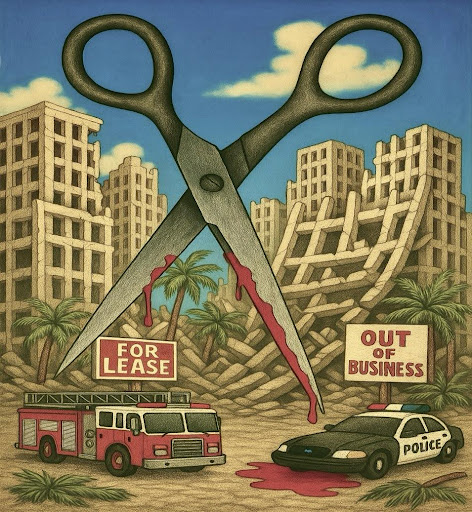
Santa Monica, once celebrated for its blend of coastal charm and progressive ideals, is slowly bleeding out — not from one dramatic failure, but from a thousand small, systemic ones. Mismanagement, unchecked spending, and leadership bloat are gradually eroding the city’s ability to function, let alone thrive. While the public is told that resources are limited, executive compensation continues to soar.
We demand accountability for homelessness, public safety, and infrastructure!
This is not just inefficiency. It is a slow, deliberate unraveling— our city is dying by a thousand cuts.
As homelessness continues to rise and essential services are strained to the breaking point, taxpayers are left wondering — who is this city working for?
When Accountability Gets Lost in Bureaucracy and Nonprofits
Statewide, we are swirling in the epicenter of what some now call the Homeless-Industrial Complex, a tangled web of bureaucracies and black-hole nonprofits that absorb public funds without being managed effectively enough to yield real, meaningful, measurable results. Millions upon millions have been spent, yet tens of thousands remain unhoused across the state. And trust in the government? No matter which side of the fence you’re on, that has become the scarcest resource.
Our Taxes Spent, Few Results
Over the past year, increasing evidence has revealed that Los Angeles’s response to homelessness is significantly fractured and poorly managed. A federal judge recently criticized the city’s efforts, likening the chaos in spending and oversight to a “derailed system” that may soon need external control if it cannot stabilize itself.
A court-mandated audit reinforced this grim picture, revealing that tracking how billions of dollars were spent was often impossible due to inconsistent and fragmented accounting practices. Service providers received large sums, but many failed to deliver measurable results — and few faced significant consequences.
Meanwhile, the Los Angeles Homeless Services Authority (LAHSA), the agency responsible for coordinating much of the region’s response to homelessness, has faced intense scrutiny. LAHSA’s CEO, Va Lecia Adams Kellum, approved a $2.1 million contract with a nonprofit where her spouse holds a senior leadership position — a decision county officials condemned as a clear ethical lapse, revealing deeper vulnerabilities in oversight.
Controller audits also found that between 2019 and 2023, roughly one out of every four city-funded shelter beds remained unoccupied, despite the visible homelessness crisis. Worse, fewer than one in five individuals who entered temporary shelters ultimately transitioned into permanent housing, while more than half returned to the streets or simply disappeared from official tracking.
The financial picture is equally bleak. Despite budgeting $1.3 billion to fight homelessness in the 2023–2024 fiscal year, the city spent less than half of it. Millions remained unused while encampments grew.
Santa Monica: A Mirror Image?
While Santa Monica often prides itself on progressive leadership and community values, many of the same warning signs are flashing there, too. Although Santa Monica has not been the subject of sweeping federal audits (yet), local activists and residents have raised serious questions about where homelessness funds are going — and why results are so hard to see.
Similar to LA, Santa Monica partners with nonprofits that have limited public visibility. Performance metrics are unclear, audits are infrequent, and the connections between city officials and service providers often remain unexplored. In a city that generates substantial tourism revenue and has a relatively small geographic footprint, the visible persistence of homelessness, particularly around downtown and Palisades Park, indicates deeper inefficiencies at play.
A Growing State and Federal Response
The issues in Los Angeles have caught the attention of higher authorities. The federal government recently announced the creation of a Homelessness Fraud and Corruption Task Force, specifically designed to investigate misuse of federal funds across Southern California. And Governor Gavin Newsom has proposed consolidating housing and homelessness programs into a new, centralized California state agency to cut down on waste and duplication.
Both moves reflect a growing recognition that throwing more money at the problem without fixing systemic inefficiencies only perpetuates failure.
Greed Knows No Party
The patterns emerging from Los Angeles and Santa Monica reveal an uncomfortable truth: greed and inefficiency don’t belong to any single political ideology. They thrive wherever transparency is weak and public accountability is an afterthought. Whether wrapped in progressive ideals or fiscal conservatism, the result is the same: public money disappears, and public problems persist.
Real Solutions Demand Real Oversight
To get serious about reducing and methodically solving homelessness, mental health and substance abuse, not just funding it, several steps are urgently needed:
- Transparent Accounting: Every contract, every dollar, publicly visible and traceable.
- Independent Auditors: Watchdogs free from political influence, with the authority to halt corrupt practices in real time.
- Nonprofit Accountability: Service organizations must meet clear benchmarks and disclose potential conflicts of interest.
- Citizen Oversight Panels: Empower everyday residents to review and evaluate spending decisions.
- Criminal Consequences: Misusing and misdirecting public funds (especially for personal benefits) must result in prosecution, not quiet retirement.
Who Pays the Price? Our City Workers and Public Safety
When city budgets are mismanaged, it’s not only about wasted funds — it’s about the real-world effects on essential services and the workers who provide them. The improper handling of funds not only impacts the city’s ability to offer essential services but also erodes the morale of frontline workers who are vital for maintaining public safety and well-being.
In Santa Monica, the disparity between executive compensation and that of frontline workers is stark. For instance, the newly appointed City Manager, Oliver Chi, is set to earn an annual salary of $410,604, alongside benefits such as up to $60,000 in temporary rental assistance and access to a home loan of up to $2 million at a favorable interest rate. How is this even remotely justifiable given the current dystopian economic landscape?
Compare that to Santa Monica’s police officers, firefighters, custodians, and administrative workers — the people responsible for public safety and daily operations, many of whom are working long hours, dealing with emergencies, and absorbing increased responsibilities with shrinking resources- who earn significantly less. Despite their critical roles, these frontline workers often face budget constraints that limit resources and staffing.
Furthermore, the city’s average employee salary in 2023 was $144,717, significantly higher than the national average, with top executives earning between $323,125 and $1.4 million. The concentration of high salaries at the top raises questions about the equitable and functional distribution of city funds, especially when essential services face financial constraints.
Our Santa Monica City Council must address these disparities NOW to ensure that city resources are used effectively and equitably.
At the end of the day, what we need is not another hollow task force or glossy new agency. True democracy is not just about casting votes or holding a particular political ideology; it’s about demanding better for the common good from those we elect. And right now, we are way overdue for selfless, serious, fearless, and committed reform on multiple levels.
Michael Jolly, for S.M.a.r.t.
Santa Monica Architects for a Responsible Tomorrow
Samuel Tolkin, Architect & Planning Commissioner; Thane Roberts, Architect; Mario Fonda-Bonardi AIA, Architect (ex-Planning Commissioner); Robert H. Taylor AIA, Architect; Dan Jansenson, Architect & Building and Fire-Life Safety Commission; Michael Jolly, AIRCRE; Jack Hillbrand, AIA, Architect, Landmarks Commissioner; Matt Hoefler NCARB, Architect; Phil Brock, SM Mayor (ret)
For previous articles, see www.santamonicaarch.wordpress.com/writing












